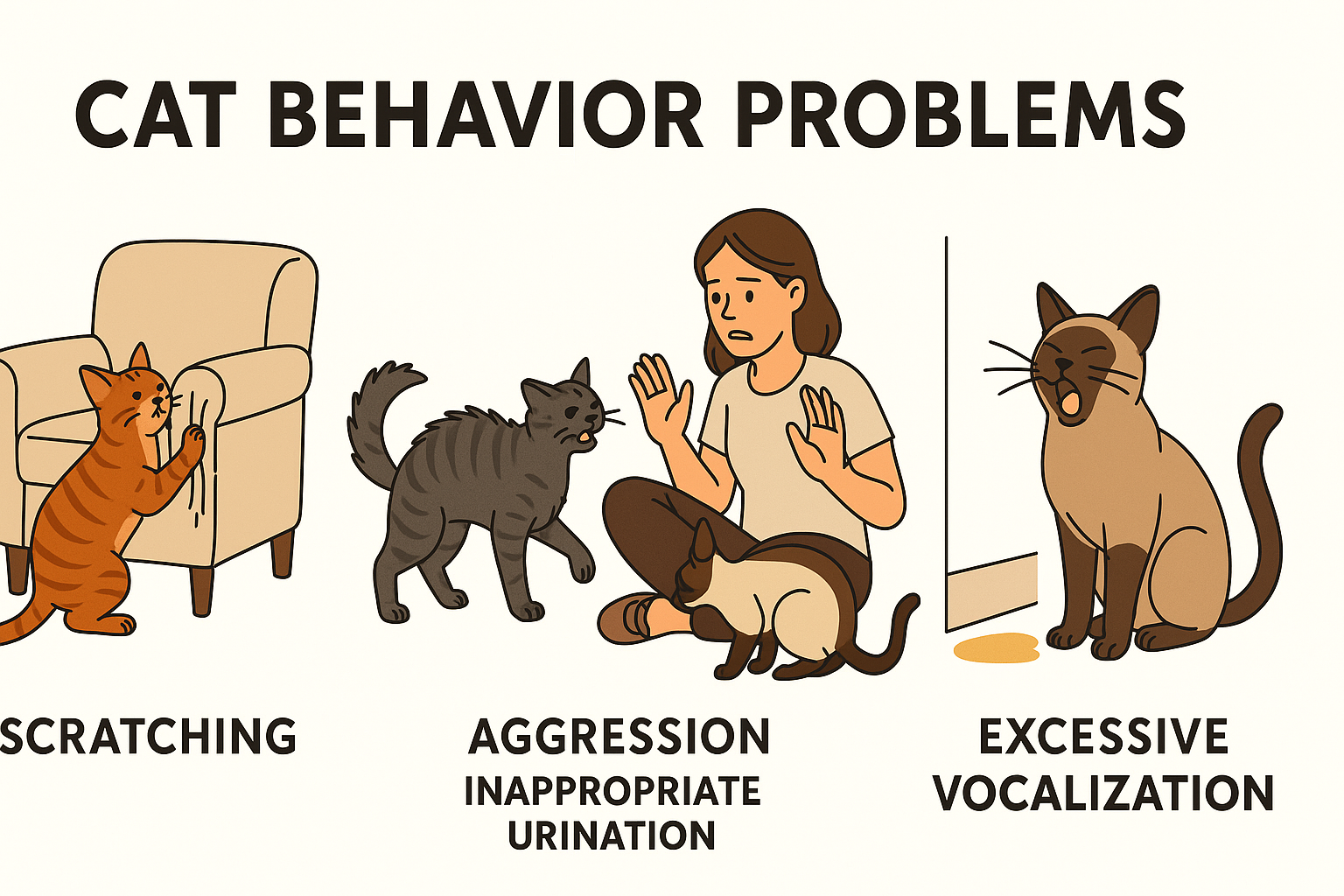Cats are fascinating companions, each with their own quirks and personalities. While many feline behaviors are normal, some can become problematic in a home environment, leading to frustration for both cats and their owners. Understanding the root causes of these behaviors is the first step toward resolving them and fostering a harmonious relationship with your pet. This article will explore the most common cat behavior problems, their underlying causes, and practical solutions to help you and your cat live together happily.
Understanding Why Cats Develop Behavior Problems
Before addressing specific issues, it’s important to recognize that many cat behavior problems are not signs of a “bad” cat, but rather responses to unmet needs, stress, or medical problems. Common causes include:
- Medical issues: Illness or pain can lead to behavioral changes, such as aggression or inappropriate elimination. Always rule out health problems with your veterinarian before addressing the behavior itself.
- Environmental changes: Moving, new furniture, or new family members (human or animal) can stress cats and trigger undesirable behaviors.
- Stress and anxiety: Cats are sensitive to changes in routine, loud noises, and conflicts with other animals.
- Lack of stimulation: Boredom can lead to destructive behaviors like scratching or excessive vocalization.
- Improper socialization: Kittens not exposed to a variety of people, pets, and environments may develop fear or aggression later in life.
- Territorial issues: Cats may spray or become aggressive if they feel their territory is threatened.
- Genetic predisposition and past trauma: Some cats are more prone to behavioral issues due to their genetic makeup or a history of trauma or abuse.
Addressing the underlying cause is key to solving any behavioral problem.
1. Inappropriate Elimination (Litter Box Problems)
One of the most common and frustrating cat behavior problems is urinating or defecating outside the litter box. This issue can have several causes:
- Medical conditions: Urinary tract infections, kidney disease, or arthritis can make using the litter box painful.
- Litter box aversion: Cats may dislike the type of litter, the cleanliness of the box, or its location.
- Stress or territorial marking: Changes in the home or the presence of other animals can prompt marking behaviors.
Solutions:
- Veterinary checkup: Always rule out medical problems first.
- Litter box hygiene: Scoop daily and clean the box regularly. Provide one box per cat, plus one extra, in quiet, accessible locations.
- Litter preferences: Experiment with different types of litter and boxes to find what your cat prefers.
- Reduce stress: Provide hiding spots, vertical spaces, and consistent routines to help your cat feel secure.
- Address marking: Neutering or spaying can reduce marking. If conflict with other pets is an issue, gradual introductions and environmental enrichment can help.
2. Aggression
Aggression in cats can be directed at people or other animals and may appear as hissing, swatting, biting, or chasing. It often stems from fear, pain, redirected frustration, or territorial disputes.
Common triggers include:
- Fear or anxiety: New environments, loud noises, or unfamiliar people or pets.
- Pain or medical issues: Arthritis, dental pain, or other illnesses.
- Redirected aggression: A cat sees something upsetting (like another cat outside) and lashes out at whoever is nearby.
- Territorial disputes: Especially in multi-cat households.
Solutions:
- Rule out pain: A vet check is essential to exclude medical causes.
- Avoid punishment: Yelling or physical correction can increase fear and aggression.
- Behavior modification: Use techniques like desensitization and counterconditioning. Gradually expose your cat to triggers at a level they can tolerate, rewarding calm behavior with treats or affection.
- Environmental management: Provide plenty of vertical space, hiding spots, and resources (food, water, litter boxes) to reduce competition.
- Professional help: For persistent aggression, consult a certified animal behaviorist or your veterinarian.
3. Scratching Furniture
Scratching is a natural behavior for cats. It helps them mark territory, stretch, and keep their claws healthy. However, it becomes a problem when cats target furniture, carpets, or other household items.
Why cats scratch:
- Marking territory: Both visually and with scent glands in their paws.
- Exercise and claw maintenance: Scratching helps remove old claw sheaths.
- Boredom or stress: Lack of stimulation can increase destructive scratching.
Solutions:
- Provide alternatives: Offer a variety of scratching posts and pads in different materials and orientations (vertical and horizontal).
- Location matters: Place scratchers near favorite resting spots and in areas where your cat already scratches.
- Encourage use: Use catnip or treats to attract your cat to the scratchers.
- Discourage unwanted scratching: Cover furniture with double-sided tape or use furniture protectors. Never declaw, as this is painful and can cause long-term problems.
- Trim claws regularly: Shorter claws cause less damage.
4. Excessive Meowing or Vocalization
Some cats are naturally more vocal, but excessive meowing can indicate an underlying problem.
Possible reasons:
- Attention-seeking: Cats quickly learn that meowing gets a response from their humans.
- Medical issues: Pain, cognitive dysfunction (especially in older cats), hyperthyroidism, or sensory loss.
- Stress or anxiety: Changes in the home or separation from a favorite person.
Solutions:
- Veterinary checkup: Rule out medical causes, especially if the behavior is new or sudden.
- Ignore attention-seeking meows: Do not reward the behavior with attention. Reward quiet behavior instead.
- Routine and enrichment: Provide a consistent daily schedule and plenty of playtime to reduce boredom.
- Address anxiety: Use pheromone diffusers, provide safe spaces, and keep routines predictable.
5. Compulsive Behaviors
Compulsive behaviors in cats can include overgrooming, tail-chasing, wool-sucking, or repetitive pacing. These behaviors often develop in response to chronic stress, anxiety, or lack of stimulation.
Common compulsive behaviors:
- Overgrooming: Licking or chewing fur to the point of baldness.
- Wool-sucking: Sucking or chewing on fabric, plastic, or other non-food items.
- Pacing or tail-chasing: Repetitive, purposeless movements.
Solutions:
- Veterinary evaluation: Rule out skin conditions, allergies, or pain.
- Reduce stress: Identify and address sources of anxiety in the home.
- Environmental enrichment: Increase playtime, puzzle feeders, and opportunities for exploration.
- Professional help: Severe cases may require medication or consultation with a veterinary behaviorist.
6. Separation Anxiety
While cats are often seen as independent, some develop anxiety when left alone. Signs include excessive vocalization, destructive behavior, inappropriate elimination, or overgrooming when their favorite person is absent.
Solutions:
- Gradual departures and arrivals: Avoid making a big fuss when leaving or returning home.
- Enrichment: Leave toys, puzzle feeders, and safe viewing spots (like window perches) to keep your cat occupied.
- Companionship: In some cases, another pet can help, but only if your cat enjoys the company of other animals.
- Consult a professional: For severe cases, a behaviorist or veterinarian can recommend behavior modification strategies or medication.
7. Fearfulness and Hiding
Some cats are naturally shy, but excessive hiding or fearfulness can indicate a problem, especially if the behavior is sudden. Triggers might include loud noises, unfamiliar people or animals, or changes in the environment.
Common causes:
- Lack of socialization: Kittens not exposed to a variety of experiences may grow up fearful.
- Past trauma: Rescue cats or those with a history of mistreatment often show more anxiety.
- Sudden changes: New furniture, renovations, or visitors can unsettle a cat.
Solutions:
- Safe spaces: Provide cozy, quiet hiding spots where your cat can retreat and feel secure.
- Gentle exposure: Gradually introduce your cat to new people or environments, allowing them to explore at their own pace.
- Consistency: Keep routines as predictable as possible, especially during changes.
- Positive reinforcement: Reward your cat for brave behavior with treats or gentle affection.
- Patience: Never force a fearful cat to interact. Let them come out when they feel safe.
8. Problems in Multi-Cat Households
Living with multiple cats can be rewarding, but it also introduces unique challenges. Common issues include fighting, resource guarding, or one cat bullying another.
Why do these problems occur?
- Territorial disputes: Cats are territorial and may not want to share space or resources.
- Competition for resources: Not enough food bowls, litter boxes, or sleeping spots can cause conflict.
- Incompatible personalities: Some cats simply do not get along.
Solutions:
- Resource management: Provide multiple food and water bowls, litter boxes, and resting places in different locations.
- Gradual introductions: When bringing a new cat home, introduce them slowly using scent swapping and short, supervised visits.
- Vertical space: Cat trees, shelves, and perches allow cats to escape or claim territory.
- Monitor interactions: Watch for bullying or persistent aggression and separate cats if necessary.
- Pheromone diffusers: Products like Feliway can help reduce tension.
- Seek professional help: For severe or persistent issues, consult a feline behaviorist.
9. Eating Non-Food Items (Pica)
Some cats develop a habit of eating non-food items, such as plastic, fabric, or plants. This behavior, known as pica, can be dangerous and may indicate an underlying problem.
Possible causes:
- Nutritional deficiencies: Rare, but possible if the diet is not balanced.
- Boredom or stress: Lack of stimulation or anxiety can lead to pica.
- Medical issues: Dental problems, gastrointestinal disease, or other health concerns.
Solutions:
- Veterinary checkup: Rule out medical or nutritional causes.
- Remove temptation: Keep dangerous items out of reach and provide safe alternatives.
- Enrichment: Increase playtime and offer a variety of toys and activities.
- Diet review: Ensure your cat is eating a high-quality, balanced diet.
10. Nighttime Activity
Many cat owners are familiar with the “midnight crazies” when their cat becomes most active at night. This is natural, as cats are crepuscular (most active at dawn and dusk), but it can disrupt your sleep.
Why it happens:
- Natural instincts: Cats’ ancestors hunted at dawn and dusk.
- Boredom: Cats left alone during the day may have excess energy at night.
- Hunger: Some cats wake their owners for food.
Solutions:
- Interactive play: Schedule play sessions in the evening to tire your cat out.
- Feeding schedule: Feed your cat a meal right before bedtime.
- Ignore attention-seeking: Do not reward nighttime wake-ups with food or play.
- Enrichment during the day: Puzzle feeders, window perches, and toys can help your cat use up energy while you are away.
Preventing Cat Behavior Problems
Prevention is always easier than a cure. Here are some tips to help avoid common cat behavior problems:
- Early socialization: Expose kittens to a variety of people, animals, sounds, and environments.
- Routine veterinary care: Regular checkups catch health problems early, before they affect behavior.
- Environmental enrichment: Provide toys, climbing structures, scratching posts, and opportunities for play and exploration.
- Consistent routines: Cats thrive on predictability.
- Positive reinforcement: Reward good behavior with treats, praise, or play.
- Respect their boundaries: Allow your cat to initiate interactions and provide safe places to retreat.
When to Seek Professional Help
If you have tried the above solutions and your cat’s behavior does not improve, or if the behavior is severe (such as aggression that causes injury), it is time to consult a professional. Your veterinarian can rule out medical causes and may refer you to a certified animal behaviorist. Early intervention increases the chances of a successful outcome.
Cocnlusions
Living with cats means accepting some of their natural behaviors, but persistent problems should not be ignored. By understanding the reasons behind your cat’s actions and responding with patience, compassion, and the right strategies, you can solve most behavior problems and build a stronger bond with your feline friend.
Remember, your cat is not being “bad”-they are communicating a need or discomfort. With time, effort, and sometimes professional guidance, you and your cat can enjoy a happier, healthier life together.
- Parrotlets (Personality, Care, Health, Nutrition, & Cost) - June 20, 2025
- Caique (Personality, Care, Health, & Nutrition) - June 20, 2025
- The Complete Guide to Golden Retrievers - June 9, 2025















